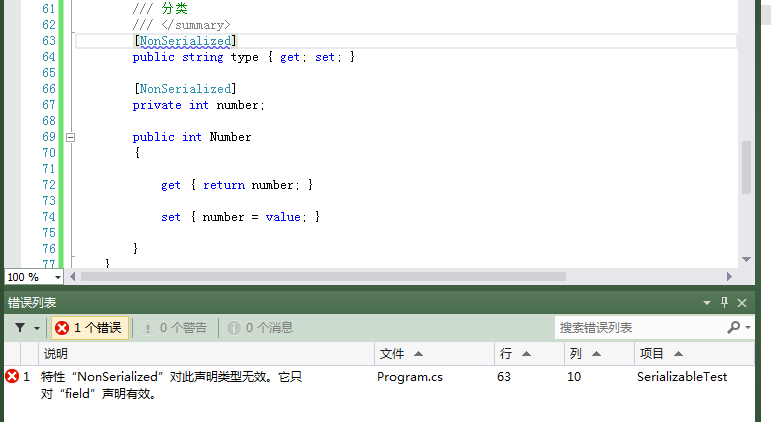基础命名空间:序列化 System.Runtime.Serialization
对象通常都有状态(state),从一个对象中抽取这种状态,不论是将它存储于某地,还是通过网络传送,这种抽取动作称为“将一个对象序列化”,而反向处理过程,从一个被序列化的状态重建一个对象即为反序列化。
序列化工作系由一个特定的格式化器(formatter)完成,每个格式化器都提供Serialize和Deserialize两个方法。当格式化器将某个对象序列化后,所得好结果被放入一个流(Stream)中,(所谓的流是字节序列的一个抽象概念)因此可以包容任何序列化格式。一对象被存储于一个流之中,对象的状态好久可以被存储于磁盘上(或者说被持久化(persistent))
对于一个可被序列化的类型,只需要给他表上[Serializable]特性,也可以只赋给某个特定的字段
NonSerialized 指明被标记的字段不可序列化
下面是自己练习的示例:
1.二进制序列化
using System; using System.Collections.Generic; using System.IO; using System.Linq; using System.Runtime.Serialization; using System.Runtime.Serialization.Formatters.Binary; using System.Text; using System.Threading.Tasks; namespace SerializableTest { public class Program { static void Main(string[] args) { Goods good = new Goods(); good.name = "苹果"; good.price = 10; good.type = "水果"; string dir = System.AppDomain.CurrentDomain.BaseDirectory; //序列化 IFormatter formatter = new BinaryFormatter(); Stream stream = new FileStream(dir+"test.bin", FileMode.Create, FileAccess.Write); formatter.Serialize(stream, good); stream.Close();//必须关闭 //反序列化 IFormatter reformatter = new BinaryFormatter(); Stream filestream = new FileStream(dir+"test.bin", FileMode.Open, FileAccess.Read); //返回Object类型,必须强制转换 Goods newgood = (Goods)reformatter.Deserialize(filestream); Console.WriteLine(newgood.name); Console.WriteLine(newgood.price); Console.WriteLine(newgood.type); Console.ReadLine(); } } [Serializable] public class Goods { /// <summary> /// 名称 /// </summary> public string name { get; set; } /// <summary> /// 价格 /// </summary> public double price { get; set; } /// <summary> /// 分类 /// </summary> public string type { get; set; } } }
上例使用二进制格式化器BinaryFormatter:System.Runtime.Serialization.Formatters.Binary;
注:Iformatter接口序列化对象时,只需要提供了Stream流对象就行了。将对象序列化到文件流(FileStream)、内存流(MemoryStream)、网络流(NetworkStream)都可以。
在测试 特新NonSerialized 时出现了点问题:“特性“NonSerialized”对此声明类型无效。它只对“field”声明有效”

由于C#3.0 的新特性get/set访问器,在编译的时候,编译器会自动为你生成对应的私有变量,变量名自动生成。
因此考虑 直接显示声明私有属性 private int number,并标注[NonSerialized]特性。
运行结果:

2.XML序列化
XML序列化,对象被以XML格式保存,XML序列化常常用在Web服务项目里(最近的项目里看到有模块用到,所以自己学习一下)
System.Xml.Serialization命名空间:含有使用XML序列化所需要的类和功能
XmlSerializer类,提供序列化Serialeze()和反序列话Deserialize()方法。
XmlIgnore属性,让XmlSerializer类跳过不序列化的成员(XML序列化 Serializable和NoSerialized属性将被忽略,而是使用XmlIgnore属性,它的作用与NoSerialized类似)
例如:
/// <summary>
/// 分类
/// </summary>
[XmlIgnore]
public string type { get; set; }
Goods good = new Goods(); good.name = "苹果"; good.price = 10; good.type = "水果"; good.Number = 12; string dir = System.AppDomain.CurrentDomain.BaseDirectory; //序列化 XmlSerializer formatter = new XmlSerializer(typeof(Goods)); FileStream stream = new FileStream(dir + "test.bin", FileMode.Create, FileAccess.Write); formatter.Serialize(stream, good); stream.Close();//必须关闭 //反序列化 XmlSerializer reformatter = new XmlSerializer(typeof(Goods)); FileStream filestream = new FileStream(dir + "test.bin", FileMode.Open, FileAccess.Read); //返回Object类型,必须强制转换 Goods newgood = (Goods)reformatter.Deserialize(filestream); Console.WriteLine("名称:" + newgood.name); Console.WriteLine("价格:" + newgood.price); Console.WriteLine("种类:" + newgood.type); Console.WriteLine("数量:" + newgood.Number); Console.ReadLine();
持久化后的XML数据
<?xml version="1.0"?> <Goods xmlns:xsi="http://www.w3.org/2001/XMLSchema-instance" xmlns:xsd="http://www.w3.org/2001/XMLSchema"> <name>苹果</name> <price>10</price> <Number>12</Number> </Goods>
可以发现加了[XmlIgnore]特性的type字段没有被序列化
注:public int Number被序列化了,private int number 没有被序列化,据说XML序列化 private类型字段不能被序列化,且元素的属性必须为读/写属性。

